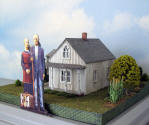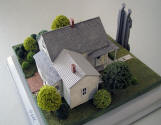|
The "American
Gothic" House in Eldon, Iowa is famous as the background of Grant Wood’s
1930 painting,
American Gothic.
This painting has become an American icon, and has been the model for
countless parodies. The house still stands and is visited by thousands
of people each year.
In 1930, artist
Grant Wood took a tour of the small town of Eldon, Iowa and spotted a little
white house with a large Gothic window. He was inspired and quickly
sketched the house and returned to his home in Cedar Rapids to do a painting
of the house. In later interviews, when asked why the house caught his
eye, Wood said he found the Gothic window amusing and called it
"pretentious" for such a small house.
The original part
of the house containing the Gothic window was built in 1881-82 by Charles
and Catherine Dibble. He owned a livery stable in Eldon and it appears
he later lost the house and it was sold for overdue taxes. Over the
years the house changed hands with the owners living in the house and in
some cases using it as a rental property. The State of Iowa acquired
it in 1991 when then-owner Carl E. Smith donated it to the State Historical
Society of Iowa.
The great Gothic
windows were believed to be for decorative purposes, and they were purchased
through the Sears-Roebuck catalog. Unknown to Grant Wood is that the
front and rear windows were hinged so large pieces of furniture could be
moved to the upper floor because the inner stairway was not suitable for
moving furniture.
The beautifully
crafted house still stands where it was first built. At one time
there were discussions about moving it to a more convenient location, but it
didn't happen. Now after its listing on the National Register of
Historic Places (listed as The Dibble House), the house is secure in its
original location.
Today, adjacent to
the house is a visitor's center. The center features an exhibition
gallery and provides costumes and props for visitors when they invariably
pose in front of the house. |



